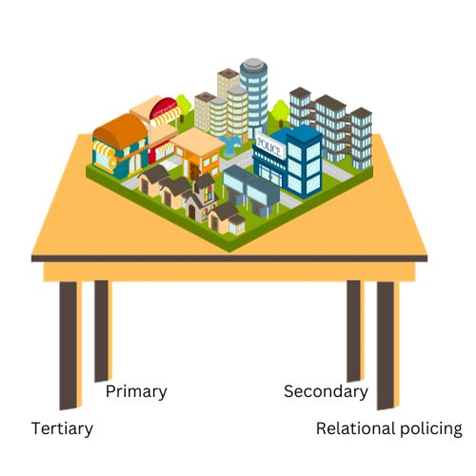
The four legs
The four-legged table serves to identify populations by levels of risk of committing violence group or gang identity and to coordinate programmatic approaches designed to reduce violence within that specific population.
The primary leg : Most individuals, even in the most violent neighborhoods in the world, would fall within the primary leg of the four-legged table. Programs designed in this leg are directed at those who are statistically least likely to be involved in violence associated with a group or gang identity. While these are typically community members of all ages, they are also specifically young people (8-17 years old) who are exposed to violence. Interventions at the primary level are the equivalent of “diet and exercise” for healthy individuals. Programs maintain and support the continued health of the community. In practice, this could look like public service media campaigns, community engagement activities, recreational programs, and youth development group activities.
The secondary leg : The secondary leg directs programming to those who are not fully involved in violence but show signs of becoming involved with violence. This population may be different depending on location. In the United States, research suggests that individuals at this level of risk are typically youth aged 10-15; in Central America, the research indicates that the age is more broadly 8-17. In any location, programs at the secondary leg target those who are “auditioning” or on the verge of becoming involved in violence associated with a group or gang identity. Interventions should be those that have shown proven effectiveness in reducing negative behavior, dysfunctional thinking patterns, and family dynamics that support violence.
The tertiary leg : The third leg is aimed at those who are at the center of violence. In most cities, this is the population that creates the negative headlines for elected officials. It is the population who, in essence, may have their fingers on the trigger, or have a gun pointed at them. They are often known to the criminal justice system; they may have been incarcerated; they may be on probation or parole; or they may be on the list of repeat offenders known by local law enforcement. This population requires a balanced approach that, on the one hand, includes services such as cognitive behavioral therapy, job training, housing, substance abuse support, and family-centered interventions and, on the other, includes engagement as potential participants in solving the problem.
Relational policing : Relational policing is included as the fourth leg of the four-legged table. Relational policing emphasizes building positive problem-solving relationships between law enforcement and the community through specific activities. Activities may include procedural justice at the crime scene, coordination with service providers in community engagement events; facilitation of support for families through victims assistance programs; and improved clearance rates of black and brown victims of homicide.
Each leg of the four-legged table is a component of the violence reduction approach for communities impacted by violence associated with a group or gang identity. Programs and interventions correspond to populations based on levels of risk and ways they are impacted by violence. When programs and interventions are executed simultaneously across all legs of the four-legged table, evidence shows that cities experience a significant reduction in violence.
9 lessons learned in municipal attempts at four-legged tables
 The four-legged table has proven to be an accessible metaphor for building collaboration and buy-in across government sectors and community stakeholders in the effort to reduce violence. However, mapping out the architecture of the table is only one aspect of successful implementation. In my decades of experience, there have been lessons learned from the efforts to execute the four-legged table in various cities.
The four-legged table has proven to be an accessible metaphor for building collaboration and buy-in across government sectors and community stakeholders in the effort to reduce violence. However, mapping out the architecture of the table is only one aspect of successful implementation. In my decades of experience, there have been lessons learned from the efforts to execute the four-legged table in various cities.

The four-legged table has proven to be an accessible metaphor for building collaboration and buy-in across government sectors and community stakeholders in the effort to reduce violence. However, mapping out the architecture of the table is only one aspect of successful implementation. In my decades of experience, there have been lessons learned from the efforts to execute the four-legged table in various cities.
The following are some of the insights gained through implementing this general strategy in specific locations.
- This is a place-based strategy. It is best executed in small, concentrated areas where data indicates violence is most likely to occur.
- The four-legged table must be lightweight enough to be able to move if the data and conditions on the ground change. Concrete tables built into the ground, meaning fixed policies not based on data, are not recommended.
- Effectiveness should be measured for each programmatic aspect of the table, assessing if the programs and intervention are working to reduce the risk of an identified population, and for the overall intention of the strategy, assessing if violence has been reduced.
- It is of critical importance that municipalities have an agreed-upon risk assessment method for identifying the population at the three levels of risk. This could include a self-reporting tool or a combination of self-reported and administrative data.
- The strategy is most effective when the technicians of the strategy have the appropriate municipal financial autonomy to drive program execution.
- Adapting the four-legged table to any location should be a design process that includes those with technical knowledge of violence reduction and those who directly experience violence on the ground.
- The strategy is most effective when program components are implemented simultaneously, rather than sequentially. A table that focuses only on one leg, say primary prevention or secondary prevention, is not likely to reduce violence.
- The probability of success improves when all legs operate in coordination with each other. As the old African proverb states: “A dog has four legs but can only walk in one direction at a time.”
- Building the table is only one step of the process. Violence reduction requires rigorous, dedicated, and coordinated implementation work.
The four-legged table represents a place-based balanced approach to reducing violence associated with a group or gang identity. It facilitates the coordination program approaches designed to “put out the fire” by interrupting the immediate violence and to “fireproof” by preventing future violence from occurring.
